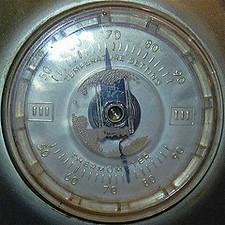Thermostat dial
Q: Jason – My home is mostly closed right now due to the heat of the summer and the cost of electricity to run the air conditioning. I am doing the simple steps to save money on my air conditioning, but what about air quality? I am essentially recycling air in my home just like in the winter. – TY
A: TY – You are absolutely correct. It doesn’t matter if it is winter or summer if you have your windows closed and the air or heater on…you are recycling air and it could be low quality air.
The US EPA says the most energy efficient and cost and the energy friendly way to deal with stale air is “Source Control” of indoor pollutants. This essentially means you need to stop doing things that contaminate your indoor air.
Here are 4 steps to help you with this issue.
Step 1: Plug the bad air intake spots. Your house is going to tend to suck in air because of the negative pressure created by fans, AC, furnaces, wood or corn burners, or other sources. In the winter time, this is more noticeable because this inward pressure manifests itself as cold drafts that are easy to identify. In the summer warm drafts are tougher to spot. Plug up the worst bad air intake spot in your home: the fireplace chimney. The chimney acts as a filthy snorkel as it is often the path of least resistance for air to enter your home. Imagine breathing in through a creosote and ash filled snorkel and you will see why it is important to plug this air entry point airtight. Closing the damper is a good start but a Chimney Balloon will help you get the tight seal that you really need to keep your home from taking in air through this path.
Step 2: If you are doing an indoor home improvement project that includes painting, sanding, torches, welding, soldering, burning, heat gunning, harsh cleansers like Bleach or Ammonia, or any other activity that puts something into the air other than your breath…you will be better served to open your home to the outside than to keep it closed up. At a minimum, open up the room you are working in to air it out. If you don’t, your return vents suck this in and circulate it through your house repeatedly.
Step 3: Display your nice paraffin or scented candles but don’t burn them. Anything you burn from candles to wood in the fireplace is going to introduce toxins into your air through smoke and carbon. There are some friendlier Soy-based candles that are not nearly as polluting as regular scented candles, but they should be used with a trimmed wick so the flame does not get too long. This probably goes without saying but smoking cigarettes and pipe in the house is horrible for everyone in the home, especially when the house is closed.
Step 4: Don’t bother with tabletop air purifiers or ridiculous amounts of houseplants. The US EPA does not certify or endorse air cleaning filters. And third-party testing labs like Consumer Reports do not give glowing reviews of any air filter products. As a matter of fact, they have found some filter systems tend to introduce more ozone than is healthy. And the US EPA says the small amount of plants helps with carbon dioxide levels but does nothing for air pollutants. Too many moist plants can cause mold issues. When it comes to air filters and plants it is best to focus your energy on other ways to make a dent in indoor pollutants.
